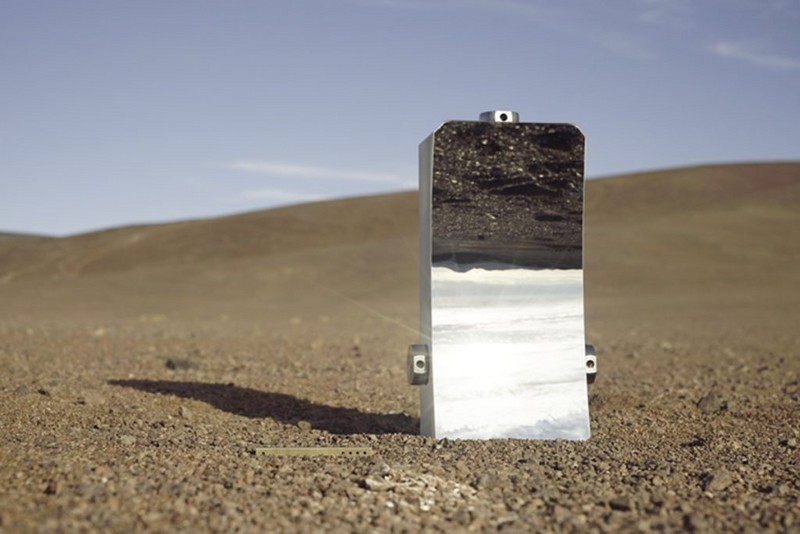Mark Geffriaud
22 Sep - 11 Dec 2016
MARK GEFFRIAUD
Deux mille quinze
22 September – 11 December 2016
Curator : Xavier Franceschi
The film installation at the heart of the exhibition conceived by Mark Geffriaud for le plateau explores our relationship to time. The film consists of footage of two different locations, namely, the construction site of the largest telescope in the world in the Atacama Desert, Chile, and the shores of Lake Titicaca, between Peru and Bolivia, where large building stones were abandoned more than a thousand years ago.
From the top of Mount Armazones, where the future telescope will stand, astrophysicists hope to travel back in time and witness the birth of the first galaxies. The piedras cansadas (tired stones), abandoned for unknown reasons during their transport to the city of Tiwanaku, have given rise to much speculation by archaeologists. The various theories on the building for which they were intended rely on the past to construct various projections of a future that will forever remain fictitious.
In Geffriaud’s film, each site becomes the mirror image of the other: the highest technology, in the near future, will project us into the most distant past, while the traces of ancient civilizations and ancestral techniques carry us back into the past, from where we consider other futures.
Between these two sites lies the land of the Aymara, the only people on earth that has an inverted concept of time, with the past lying ahead and the future behind it. Shifting from one site to the other therefore implies crossing a region where our relationship to time is upended. This reversal of time is also reflected in the arrangement of the exhibition, which is punctuated by screenings of the film, random interruptions, and the flow of the soundtrack in all the rooms. Similarly, the soundtrack itself retraces the journey between the two sites by following the development of the project in reverse.
The work of Mark Geffriaud (born 1977) is based on the production of installations, sculptures and films that focus on the construction of time and memory. Since 2007 his work has been shown in numerous museums and galleries in France (Centre Pompidou, Palais de Tokyo, Musée national du Jeu de Paume, Musée d’art moderne de Paris, etc.) and abroad (Tate Modern, London; De Appel, Amsterdam; National Gallery, Prague; Mamco, Geneva; etc.). His work can also be found in various national collections (Centre Pompidou, Musée d’art moderne de Paris, frac île-de-france).
The film by Mark Geffriaud will also be shown as part of his personal exhibition in Rotterdam in autumn 2016 (Witte de With, 14 October 2016–4 January 2017).
This project has received the kind support of the Meurice Prize for Contemporary Art in 2014.
Deux mille quinze
22 September – 11 December 2016
Curator : Xavier Franceschi
The film installation at the heart of the exhibition conceived by Mark Geffriaud for le plateau explores our relationship to time. The film consists of footage of two different locations, namely, the construction site of the largest telescope in the world in the Atacama Desert, Chile, and the shores of Lake Titicaca, between Peru and Bolivia, where large building stones were abandoned more than a thousand years ago.
From the top of Mount Armazones, where the future telescope will stand, astrophysicists hope to travel back in time and witness the birth of the first galaxies. The piedras cansadas (tired stones), abandoned for unknown reasons during their transport to the city of Tiwanaku, have given rise to much speculation by archaeologists. The various theories on the building for which they were intended rely on the past to construct various projections of a future that will forever remain fictitious.
In Geffriaud’s film, each site becomes the mirror image of the other: the highest technology, in the near future, will project us into the most distant past, while the traces of ancient civilizations and ancestral techniques carry us back into the past, from where we consider other futures.
Between these two sites lies the land of the Aymara, the only people on earth that has an inverted concept of time, with the past lying ahead and the future behind it. Shifting from one site to the other therefore implies crossing a region where our relationship to time is upended. This reversal of time is also reflected in the arrangement of the exhibition, which is punctuated by screenings of the film, random interruptions, and the flow of the soundtrack in all the rooms. Similarly, the soundtrack itself retraces the journey between the two sites by following the development of the project in reverse.
The work of Mark Geffriaud (born 1977) is based on the production of installations, sculptures and films that focus on the construction of time and memory. Since 2007 his work has been shown in numerous museums and galleries in France (Centre Pompidou, Palais de Tokyo, Musée national du Jeu de Paume, Musée d’art moderne de Paris, etc.) and abroad (Tate Modern, London; De Appel, Amsterdam; National Gallery, Prague; Mamco, Geneva; etc.). His work can also be found in various national collections (Centre Pompidou, Musée d’art moderne de Paris, frac île-de-france).
The film by Mark Geffriaud will also be shown as part of his personal exhibition in Rotterdam in autumn 2016 (Witte de With, 14 October 2016–4 January 2017).
This project has received the kind support of the Meurice Prize for Contemporary Art in 2014.

